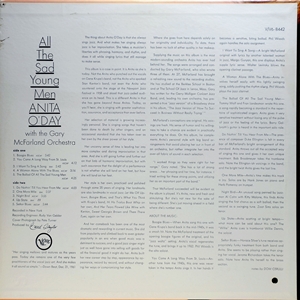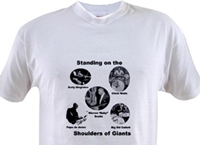
This album may have not been Anita's best, but it does rank among her better albums during her Verve years. More importantly, the way it was recorded was groundbreaking - for 1961. Finally, I am personally intrigued by the veiled reference to F. Scott Fitzgerald. Before going into all of that, here is the back cover of the album containing the liner notes. I think it makes for interesting reading. Click on the image for a much larger, readable one:

About the F. Scott Fitzgerald theory. He wrote a collection of short stories in 1926 titled All the Sad Young Men that reflected some trying situations he was experiencing. One major one was he suspected his wife Zelda of having an affair. Consider some of the song selections here: Do Nothing Until You Hear From Me, A Woman Alone With the Blues, and, of course, The Ballad of the Sad Young Men. Is there a connection? Perhaps; perhaps not. I am getting up there in years, so my theory may be more a symptom of dementia than some special insight. Note: you can listen to samples of each track by visiting this page. Here are a few of the tracks in their entirety to give you a taste of what's on the album:
Track 5 - Ballad of all the Sad Young Men
Remember my saying that this was groundbreaking in some aspects? Here is why, as related by Anita in Chapter XI of her autobiography, High Times, Hard Times: The orchestra recorded in New York and the arranger, Gary McFarland, sent her the tapes and charts via the mail. She showed up in a Hollywood studio to add the vocals which were recorded along with the playback of the orchestra backing her. She said all she had were charts with annotations like, "ad lib here", and stood on a box in the recording booth and provided the vocals into a mic while the backing was piped through speakers. She also mentioned that she never met McFarland until four or five years later!
If you are a recording engineer of musician today you are probably thinking, 'what's the big deal?' For one thing the only folks doing multi-track recording in 1961 were Les Paul who pretty much invented it, and a genius engineer at Atlantic Records named Tom Dowd (his story is in Tom Dowd & the Language of Music). So, in one respect, this album was groundbreaking for the way it was put together.
Recording was at Englewood Cliffs, NJ on October 16, 1961 and in Los Angeles between November and December 1961. Personnel included: Bernie Glow, Doc Severinsen, Herb Pomeroy (trumpets), Bob Brookmeyer, Willie Dennis, Billy Byers (trombones), Walt Levinsky (clarinet), Phil Woods (alto sax), Jerome Richardson (bass clarinet), Zoot Sims (tenor sax), Hank Jones (piano), Barry Galbraith (guitar), George Duvivier or Art Davis (bass), Mel Lewis (drums).
While the songs seem to fit the Fitzgerald theme I mentioned above, there are some interesting pieces thrown in. For example, Anita was doing Boogie Blues with Gene Krupa when McFarland was a toddler. Including Horace Silver's Senor Blues was a, well, hip move on the producer's part in my opinion.
All in all this is among my favorite O'Day albums, but still not in the top five. That is my personal taste. I will say that you could not go wrong with this or any of her albums from her Verve years. And, as a drummer, it is always a treat studying Mel Lewis.
My next general post will be a review of Rifftide: The Life and Opinions of Papa Jo Jones, and my next post in this Anita O'Day series will cover one of the best bargains an Anita O'Day fan will ever find: Anita O'Day Eight Classic Albums.



No comments:
Post a Comment